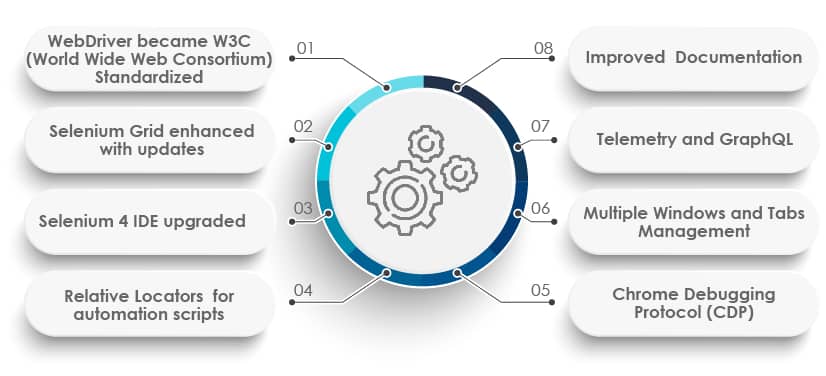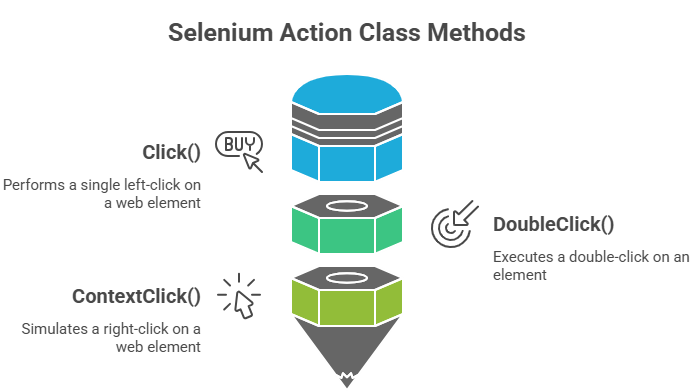
- Introduction to Selenium WebDriver
- What is the Action Class in Selenium?
- Why Use the Action Class?
- Common Methods of the Action Class
- How to Implement Action Class in Selenium
- Use Cases of Action Class
- Handling Complex User Interactions
- Best Practices When Using Action Class
Introduction to Selenium WebDriver
Selenium WebDriver is a powerful and widely used open-source tool for automating web application testing across various browsers. It allows developers and testers to write scripts in multiple programming languages like Java, Python, and C#, making it versatile and developer-friendly. One of the key features that enhances its flexibility is the Action Class in Selenium, which enables the simulation of complex user gestures such as mouse movements, clicks, drag-and-drop, and keyboard events. This is especially useful for testing interactive web applications. Beyond testing, Selenium WebDriver is also frequently used for web scraping Python Selenium projects, where developers extract data from websites using Python scripts integrated with Selenium’s browser automation capabilities. While Selenium is a technology-focused term, some confusion occasionally arises with similar-sounding terms like Selenomethionine Thyroid, which is actually a selenium-based compound used in medical diagnostics and has no connection with Selenium WebDriver. Nevertheless, Selenium WebDriver continues to be a foundational tool in the automation testing ecosystem, allowing teams to build robust and scalable test suites for modern web applications. Its ability to integrate with testing frameworks and CI/CD tools makes it a go-to solution for quality assurance in Agile and DevOps environments.
Are You Interested in Learning More About Software Testing? Sign Up For Our Software Testing Certification Training Today!
What is the Action Class in Selenium?
- Performs Complex User Interactions: Action Class enables operations like double-click, right-click, and click-and-hold which are vital for automating rich web applications in Selenium Automation projects.
- Supports Mouse and Keyboard Events: It simulates real user behavior by sending keyboard inputs and controlling mouse movements, enhancing the scope of test scenarios even in platforms like Browserstack Selenium.
- Drag and Drop Functionality: Using methods like dragAndDrop(), testers can automate complex UI components, which is often required in frameworks like RobotFramework for seamless automation integration.
The Action Class in Selenium is a part of the org.openqa.selenium.interactions package that enables users to perform complex user gestures such as mouse movements, clicks, drag-and-drop, and keyboard events in Selenium Automation. It is especially useful when standard WebDriver commands are insufficient to interact with dynamic or advanced UI components during test execution. Here’s a breakdown of its features and uses:

- Helpful in Selenium Web Scraping: Action Class can help navigate through interactive web elements during Selenium web scraping, ensuring accurate data collection from dynamic sites.
- Works with Dynamic Elements: It allows interactions with hover menus, sliders, and tooltips, where simple click commands often fail to deliver.
- Not Related to Selenomethionine: Despite the name’s similarity, Selenomethionine is a dietary supplement and unrelated to Selenium’s automation or testing capabilities.
Why Use the Action Class?
The Action Class in Selenium is essential for automating complex user interactions that go beyond basic click and type commands. It enables testers to replicate real-world gestures such as right-clicks, double-clicks, mouse hovers, drag-and-drop, and key presses actions that are crucial for interacting with dynamic and modern web applications. These capabilities make it especially valuable in scenarios where standard WebDriver methods fall short, such as working with advanced UI components or custom controls. For instance, in web scraping Python Selenium projects, the Action Class is used to navigate interactive elements like dropdowns or hover menus to accurately extract hidden or dynamically loaded data. Its importance becomes even more apparent when testing responsive or JavaScript-heavy sites, where user behavior plays a key role in revealing content. While exploring Selenium, some users might encounter the term Selenomethionine Thyroid, which is unrelated and refers to a nutritional supplement used in thyroid health highlighting the importance of distinguishing between similar-sounding terms. Overall, the Action Class is a powerful tool that brings human-like control to automated scripts, enhancing the precision, reliability, and realism of test automation. Whether used in testing or data extraction, it is an indispensable feature for mastering Selenium’s full potential.
To Explore Software Testing in Depth, Check Out Our Comprehensive Software Testing Training Course To Gain Insights From Our Experts!
Common Methods of the Action Class
- Click(): Performs a single left-click on the targeted web element, often used in dynamic UI flows or during Selenium web scraping.
- DoubleClick(): Executes a double-click on an element, ideal for triggering JavaScript events or interacting with image viewers and file lists.
- ContextClick(): Simulates a right-click on the specified element, commonly used for testing context menus in web applications.
The Action Class in Selenium provides a wide range of methods to simulate complex user interactions during Selenium Automation. These methods are especially useful for handling advanced UI components where simple commands fall short. Whether you’re using Browserstack Selenium for cross-browser testing or integrating with RobotFramework, the Action Class enhances your test execution with precision. Here are six commonly used methods:

- MoveToElement(): Moves the mouse to a specified web element, which is crucial for hover effects, dropdowns, and advanced components in automation platforms like Browserstack Selenium.
- DragAndDrop(): Clicks and holds one element, moves it to another, and releases helpful drag-and-drop interfaces across different automation frameworks, including RobotFramework.
- KeyDown() and keyUp(): Simulates pressing and releasing a specific keyboard key, useful for testing keyboard shortcuts and navigation. (Not to be confused with Selenomethionine, a dietary supplement unrelated to Selenium tools.)
- Hovering Over Elements: Useful for revealing hidden menus or tooltips that appear only on mouseover common in e-commerce sites or dropdown-based navigation systems.
- Right-Click Context Menu Testing: contextClick() helps in verifying right-click functionalities such as custom options or context-aware menus in web applications.
- Double-Click Operations: Essential for triggering JavaScript events like opening items in new tabs or expanding content dynamically, often tested in Browserstack Selenium environments.
- Drag and Drop Functionality: Allows simulating user actions where elements are moved across sections ideal for dashboards, sliders, and graphic editors tested in RobotFramework.
- Keyboard Interactions: Simulates key presses for shortcuts or form navigation, especially when working on accessibility features or SPA (Single Page Applications).
- Dynamic Element Navigation in Web Scraping: Helps navigate complex UI paths during Selenium web scraping. (Note: unrelated to Selenomethionine, which is a supplement, not a testing tool.)
How to Implement Action Class in Selenium
To implement the Action Class in Selenium, you first need to create an instance of the Actions class by passing the WebDriver object to it. This allows you to chain a series of user-like interactions such as mouse movements, clicks, drag-and-drop, and keyboard events. These interactions are essential for testing dynamic elements that don’t respond to basic Selenium commands. After creating the actions object, you can use methods like moveToElement(), click(), doubleClick(), contextClick(), and dragAndDrop() to simulate user behavior. Once the action sequence is defined, calling .build().perform() executes the commands. This implementation is especially powerful in web scraping Python Selenium projects, where hovering over elements or clicking through dropdowns is necessary to extract hidden data. It also plays a vital role in automating real user scenarios across modern websites. However, while working with Selenium, it’s important not to confuse it with Selenomethionine Thyroid, a selenium-based supplement used in medical treatments and entirely unrelated to automation testing. By mastering the Action Class in Selenium, testers can handle sophisticated testing needs, improve script accuracy, and ensure better coverage for complex web interfaces. It’s a fundamental skill for anyone serious about advanced Selenium automation.
Want to Pursue a Software Testing Master’s Degree? Enroll For Software Testing Master Program Course Today!
Use Cases of Action Class
The Action Class in Selenium is highly useful when automating tasks that mimic real-world user behavior on web applications. It extends the capabilities of Selenium WebDriver by handling advanced gestures and interactions, making it essential for robust Selenium Automation. Whether you’re running tests on Browserstack Selenium, integrating with RobotFramework, or conducting Selenium web scraping, the Action Class enhances flexibility and precision. Below are some common use cases:
Handling Complex User Interactions
Handling complex user interactions is a crucial aspect of Selenium Automation, especially when dealing with dynamic web applications that require more than simple clicks and text input. These interactions include mouse hovers, drag-and-drop, right-clicks, keyboard shortcuts, and more actions that closely mimic real user behavior. Selenium’s Action Class is specifically designed to manage such scenarios, allowing testers to simulate multi-step gestures accurately. Whether you’re executing tests across various browsers using Browserstack Selenium or integrating tests into RobotFramework, mastering these complex interactions ensures robust test coverage and reliability. Additionally, in Selenium web scraping projects, complex interactions like hovering to reveal hidden data or navigating through dynamic content must be automated precisely to extract accurate information. The Action Class empowers you to chain these events seamlessly using methods like moveToElement(), clickAndHold(), release(), and keyDown(). While working in this domain, it’s important to distinguish between Selenium-related terms and unrelated ones like Selenomethionine, a selenium-based compound used in thyroid treatments and not connected to web testing. Effectively handling complex interactions is essential for validating real-world scenarios, ensuring that your automated tests are as close to actual user behavior as possible, ultimately leading to higher quality web applications.
Best Practices When Using Action Class
When working with the Action Class in Selenium, following best practices ensures stable, reliable, and maintainable automation scripts. One key practice is to always wait for elements to be visible and interactable before performing actions; this reduces the risk of flaky tests, especially when dealing with dynamic content. Structuring actions using build().perform() allows better control over execution, particularly when chaining multiple gestures like hover and click. For cleaner code, encapsulate repetitive interactions into reusable methods. During web scraping Python Selenium tasks, the Action Class can be critical for handling advanced navigations like dropdowns or hover-activated content, so incorporating proper exception handling helps manage unpredictable behavior. Also, using descriptive element locators enhances readability and debugging. It’s essential to avoid hardcoded waits; instead, implement explicit waits to synchronize actions effectively. For visual feedback or debugging, take screenshots after performing complex actions. While diving into Action Class, remember that Selenomethionine Thyroid is unrelated to Selenium automation; it’s a dietary supplement used in medical contexts, not web testing. Mastering these best practices when using the Action Class in Selenium will improve the reliability of your automation framework and ensure smooth interaction with sophisticated UI elements, making your tests both efficient and closer to real-user scenarios.

